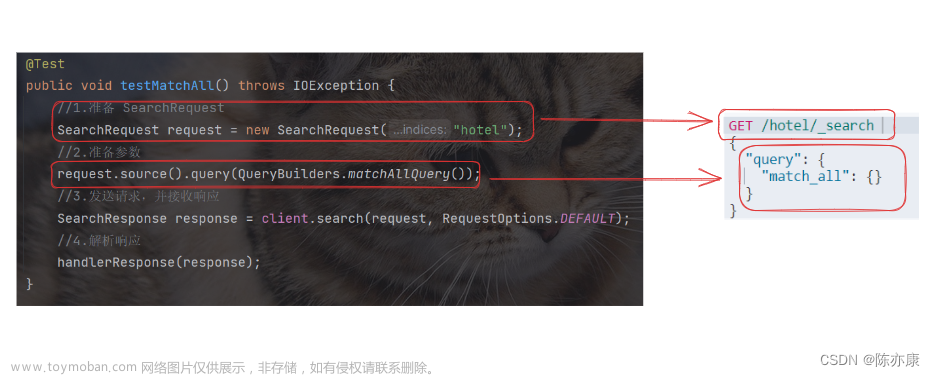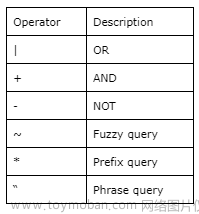前言
ES 里面有 5 种复合查询,分别是:
- Boolean Query
- Boosting Query
- Constant Score Query
- Disjunction Max Query
- Function Score Query
Boolean Query在之前已经介绍过了,今天来看一下 Boosting Query 用法,其实也非常简单,总结起来就一句话,对不期待的查询关键词进行相关性降分。
Boost 加权机制底层也是 Lucene 提供的能力,对重要的数据加权有两个时机,一个是在索引时,一个是在查询时,在索引时候加权查询性能会比较高但不灵活,所以都会选择在查询时加权,加权的方式也很简单,如:
title: china^20 OR content: china^20在 ES里面的大多数全文检索 单 Query 都支持 boost 加权,但想要实现降权却不行,因为 Lucene 底层不直接支持,需要使用 function score query来间接实现,boost 的数值必须是正数,当然也可以包括 0-1 之间的小数,所以在 ES 中就封装了 Boosting Query 来支持对某些关键词进行降权查询,却又不是不让其出现在查询结果中,只是让其排名靠后
写入测试数据
在 kibana 中的 dev_tools 的 console 中,直接使用下面的 POST 语句即可,需要注意,如果 ES
版本低于 7.x 的,在 PATH 里面要加上 type,否则会报错:
POST test01/doc/_bulk
{ "index" : { "_id" : "1" } }
{ "title" : "Collecting Service", "content": "Logstash" }
{ "index" : { "_id" : "2" } }
{ "title" : "Collecting Service", "content": "Beats" }
{ "index" : { "_id" : "3" } }
{ "title" : "Collecting Service", "content": "FLume" }写完之后,可以在 Management => Index patterns => Create Index Patterns 里面创建手动创建索引模板,可以看到生成了如下 mapping,需要注意的时,这里面自动推断的 mapping 字段并不能删减字段,因为我们是已经
将数据写入了 ES,如果想要控制字段的生成,比如不想要 content.keyword 字段,那么就要在写入数据前,提前定制 mapping 才可以

查询测试数据
GET test01/_search?
{
"query": {
"match": {
"title": "Collecting"
}
}
}返回结果:
{
"took" : 2,
"timed_out" : false,
"_shards" : {
"total" : 6,
"successful" : 6,
"skipped" : 0,
"failed" : 0
},
"hits" : {
"total" : 3,
"max_score" : 0.2876821,
"hits" : [
{
"_index" : "test01",
"_type" : "doc",
"_id" : "3",
"_score" : 0.2876821,
"_source" : {
"title" : "Collecting Service",
"content" : "FLume"
}
},
{
"_index" : "test01",
"_type" : "doc",
"_id" : "2",
"_score" : 0.2876821,
"_source" : {
"title" : "Collecting Service",
"content" : "Beats"
}
},
{
"_index" : "test01",
"_type" : "doc",
"_id" : "1",
"_score" : 0.2876821,
"_source" : {
"title" : "Collecting Service",
"content" : "Logstash"
}
}
]
}
}
可以看到评分都相等,这个时候如果我想要命中 logstash 的不优先展示,就可以使用 Boosting Query 了:
GET test01/_search?
{
"query": {
"boosting": {
"positive": {
"match": {
"title": "Collecting Service"
}
},
"negative": {
"match": {
"content": "Logstash"
}
},
"negative_boost": 0.5
}
}
}结果展示:
{
"took" : 2,
"timed_out" : false,
"_shards" : {
"total" : 6,
"successful" : 6,
"skipped" : 0,
"failed" : 0
},
"hits" : {
"total" : 3,
"max_score" : 0.5753642,
"hits" : [
{
"_index" : "test01",
"_type" : "doc",
"_id" : "3",
"_score" : 0.5753642,
"_source" : {
"title" : "Collecting Service",
"content" : "FLume"
}
},
{
"_index" : "test01",
"_type" : "doc",
"_id" : "2",
"_score" : 0.5753642,
"_source" : {
"title" : "Collecting Service",
"content" : "Beats"
}
},
{
"_index" : "test01",
"_type" : "doc",
"_id" : "1",
"_score" : 0.2876821,
"_source" : {
"title" : "Collecting Service",
"content" : "Logstash"
}
}
]
}
}
Boosting Query原理
Positive Boosting:
这种形式用于增强具有特定条件的文档的得分。它由两个子查询组成:主查询(positive query)和副查询(boost query)。主查询用于匹配文档,而副查询用于对匹配到的文档进行权重调整。Boosting Query将副查询的分数与主查询的分数相乘,从而影响文档的最终得分。
Negative Boosting:
这种形式用于降低具有特定条件的文档的得分。它同样由两个子查询组成:主查询和副查询。在Negative Boosting中,主查询用于匹配文档,而副查询用于对不匹配的文档进行权重调整。Boosting Query将副查询的分数与主查询的分数相乘,并将结果从1中减去,以降低不匹配文档的得分。文章来源:https://www.toymoban.com/news/detail-660043.html
Boosting Query的实现原理如下:文章来源地址https://www.toymoban.com/news/detail-660043.html
- 解析查询语句:Elasticsearch首先解析用户提供的Boosting Query语句,提取出主查询和副查询以及相应的权重。
- 执行查询:对索引中的文档进行主查询匹配,并为匹配到的文档计算得分。
- 计算副查询得分:对于每个匹配到的文档,执行副查询,并计算副查询的得分。
- 应用权重调整:根据Boosting Query的类型(Positive Boosting或Negative Boosting),将副查询的得分与主查询的得分相乘,或者从1中减去,从而调整文档的最终得分。
- 返回结果:根据得分对匹配的文档进行排序,将搜索结果返回给用户。
到了这里,关于Elasticsearch复合查询之Boosting Query的文章就介绍完了。如果您还想了解更多内容,请在右上角搜索TOY模板网以前的文章或继续浏览下面的相关文章,希望大家以后多多支持TOY模板网!












